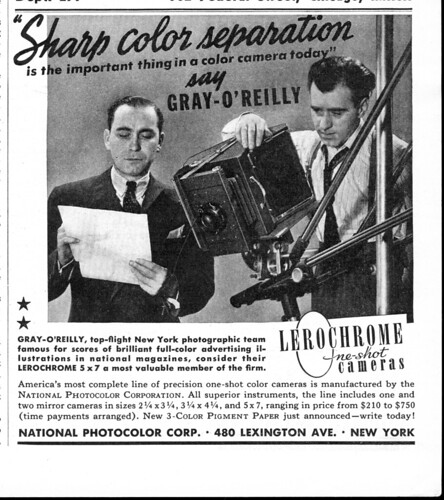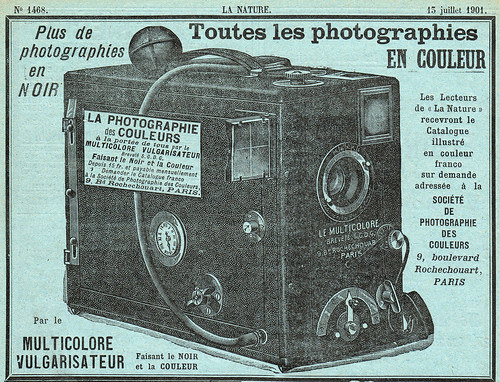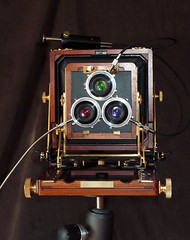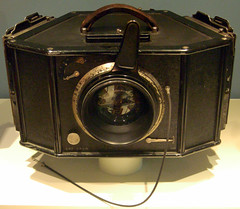Three-color camera

|
| Advertisement for Lerochrome 'one-shot' three-color cameras Popular Photography, February 1940. Scan by camerawiki (Image rights) |
Three-color cameras (color separation cameras) make separate monochrome negatives of the three primary-color components of the photographed image, to be used in color printing. This process precedes the invention of color plates or film. Even when colour plates such as Autochrome became available, printing from them was considerably more difficult than from color-separation negatives. Color-separation studio cameras continued to be made for demanding uses until the 1950s, twenty years after the introduction of Kodachrome.
In early color-separation cameras, three plates are exposed sequentially, with a red, blue and green filter respectively. Clearly, this method is not appropriate for subjects that move significantly between the exposures. However, in principle, any camera can be used for this method. Cameras sold as three-color cameras are hardly different from any other camera, except that they are provided with the correct filters. Some (for example Dr Miethe's Dreifarben-Kamera by Bermpohl, who specialised in cameras for this process) have a repeating back to allow the three exposures to be made in quick succession, and special dark-slides that hold a set of three plates side by side; in the falling-plate magazine camera shown below, the plate magazine serves the same purpose.
In the late 1920s, cameras began to be made that make the three negatives simultaneously, extending the method to more subjects. These one-shot three-color cameras use internal arrangements of half-silvered mirrors to divide the light from the lens into three parts, and direct each part to a plate (or in later cameras, film or even digital image sensor, in such cameras as the Minolta RD-175). The three images are later combined to form a full-colour image. The first 3-color camera of this one-shot type was presented in 1897 by color photography pioneer Louis Ducos du Hauron.

|
Advertisement for 'Multicolore' detective cameras with built-in filters for color separation use. Ernemann made this camera, but here it is advertised rebranded in France. La Nature, 13 July 1901. scanned by Abdishev (Image rights) |

|
| Tri-Color camera, three-lens conception image by Branislav Vojnovic (Image rights) |

|
| JosPe Tri-Color Camera, 1924 image by AWCam (Image rights) |
Samples

|
| Image made with a Butler Tricolor Camera c.1910 scanned by Hans Kerensky (Image rights) |
Links
- A selection of three-color equipment by several makers, sold at the first Westlicht Photographica Auction on 15 November 2002:
- Ives Lantern Kromskop, a projector for three-color slides, about 1899
- Ives Photochromoscope Syndkrömskop viewer for stereo color-separation slides, requiring six component images per view; about 1900
- Lesueur & Ducos du Hauron Melanochromoscope, about 1901
- Sanger Shepherd three-color camera for three images on an 8x20 cm plate; about 1904
- Ives Photochromoscope 6x6 cm Junior Kromskop, about 1905
- Sanger Shepherd stereo three-color camera about 1908
- 4.5x6 cm Jos-Pe Dreifarbenkamera, about 1925
- 9x12 cm Bermpohl Naturfarbenkamera, 1935
- Mikut Farbkamera, about 1937, making three 4x4 cm images on a single 4.5x13 cm plate
- Reckmeier & Schünemann 6x9 cm 3-Farben Kamera, about 1937
- Optikotechna Spektaretta 35 mm three-color camera, about 1939
- Notes on a color portrait of Leo Tolstoy at the University of Toronto